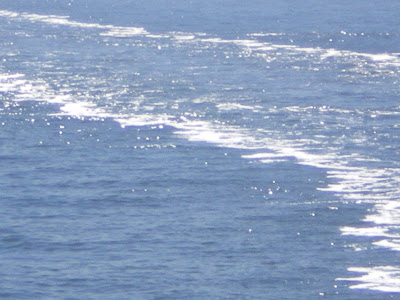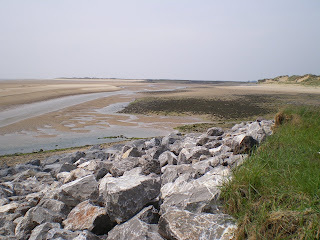

On Saturday evening (June 21) we attended a Summer Solstice party at the American Women's Club. It was a nice group of folks, and although I'd met most of the women, this event included husbands and it was quite a bit of fun.
The women who organized the event made some lovely food, and we were all encouraged to drink beer and wine. We recreated several of the traditions from other European countries (examples below) - which included jumping over a bonfire (OK, it was about six tea candles on the floor), dancing around a maypole wearing flowered headpieces, participating in a mock marriage (each man picked a woman's name out of a hat and she was his bride for the evening - Alex picked my name but they made me marry someone else). We hit each other on the head with fresh garlic for good luck, participated in a 'pet blessing' and a relay race...and several other 'hard-to-describe' but very funny activities as well.
Summer solstice is actually an astronomical term relating to the position of the Sun in relation to the equator. The summer solstice is the date with the longest day and hence with the shortest night. (the opposite way round in the Winter) This date usually falls on June 21/June 22 in the Northern hemisphere or December 21/December 22 in the Southern hemisphere. At the time of the summer solstice, the earth is most tilted towards the sun (the poles point more directly at the sun than at any other time). This causes the sun to appear at its farthest above the equator when viewed from earth. Midsummer is the time around the summer solstice, and is celebrated throughout Northern Europe.
Midsummer is one of the only pagan holidays that are still celebrated in Europe (if not the only). In Denmark and Norway it is referred to as the eve of St. Hans but it's only in Sweden that it has kept its original name. Midsummer rivals Christmas as the most important holiday of the year due to the copious amounts of alcohol consumed.
The women who organized the event made some lovely food, and we were all encouraged to drink beer and wine. We recreated several of the traditions from other European countries (examples below) - which included jumping over a bonfire (OK, it was about six tea candles on the floor), dancing around a maypole wearing flowered headpieces, participating in a mock marriage (each man picked a woman's name out of a hat and she was his bride for the evening - Alex picked my name but they made me marry someone else). We hit each other on the head with fresh garlic for good luck, participated in a 'pet blessing' and a relay race...and several other 'hard-to-describe' but very funny activities as well.
Summer solstice is actually an astronomical term relating to the position of the Sun in relation to the equator. The summer solstice is the date with the longest day and hence with the shortest night. (the opposite way round in the Winter) This date usually falls on June 21/June 22 in the Northern hemisphere or December 21/December 22 in the Southern hemisphere. At the time of the summer solstice, the earth is most tilted towards the sun (the poles point more directly at the sun than at any other time). This causes the sun to appear at its farthest above the equator when viewed from earth. Midsummer is the time around the summer solstice, and is celebrated throughout Northern Europe.
Midsummer is one of the only pagan holidays that are still celebrated in Europe (if not the only). In Denmark and Norway it is referred to as the eve of St. Hans but it's only in Sweden that it has kept its original name. Midsummer rivals Christmas as the most important holiday of the year due to the copious amounts of alcohol consumed.

In Sweden, Midsummer's Eve and Midsummer's Day is arguably the most important holiday of the year, and one of the most uniquely Swedish in the way it is celebrated, even if it has been influenced by other countries long ago. Traditional events include raising and dancing around a huge maypole. One typical dance is the frog dance.

Naturally, I did my own frog dance at an appropriate time at our celebration!
Drinking songs are also important at this feast, and many drink heavily. We tried to recreate this important element :) We didn't sing drinking songs, but we did have to write and sing a song we wrote about how we love our land...

The connection to fertility is naturally linked to the time of year. Many young people became passionate at Midsummer, and this was accepted, probably because it resulted in more childbirths in March which was a good time for children to be born.
In the Finnish midsummer celebration tradition, bonfires are burnt at lakesides. In the coastal areas that are the stronghold of the Swedish speakinbg Finns, these are supplanted by a maypole tradition, transferred from Sweden, and pickled herring. We did NOT eat any pickled herring :)

When Finland was Christianized, the holiday was named after John the Baptist in order to give a Christian meaning to the pagan holiday. The traditions, however, remain quite unchanged and survive in modern-day Finland, although they have lost their original purposes.
In folk magic, still well known but no longer seriously practiced, midsummer was a very potent night and the time for many small rituals, mostly for young maidens seeking suitors.
Many music festivals of all sizes are organized on the Midsummer weekend. A great many people get very drunk and happy. The statistics for the number of people drowned and killed in road accidents and other mishaps are morbidly counted every year while the number of assaults also peaks.

In most places in Norway, the main event is the burning of a large fire. In parts of Norway a custom of arranging mock marriages, both between adults and between children, is still kept alive. The wedding was meant to symbolise the blossoming of new life. Such weddings are known to have taken place in the 1800s, but the custom is believed to be older.

In Portugal, Saints’ days are full of fun and merriment. The streets are decorated with balloons and arches made out of brightly-coloured paper; people dance in the city's small squares, and altars, dedicated to the saints, are put up as a way of asking for good fortune. These holidays are days of festivities with good food and refreshments.
It is still the tradition in Lisbon to celebrate multiple marriages (200 to 300) and still following the tradition, if you are attracted to someone, one can declare himself in the heat of the festivities by offering to the loved person a manjerico (a flower-pot with a sweet basil plant) and a love poem. The men at our party did have to wear little herbal boutonierres.
In Operto, St John's is a festival that is lived to the full in the streets, where anything is permitted. People carry a whole plant of flowering garlic with them (or a little plastic hammer), which they use to bang their neighbours over the head for good luck. According to one Portuguese Grandmother, the tradition is that St John was a scallywag in his youth and the people hit him on the head with the garlic saying "return to the right path". There is also dancing, while the highlight of the night is the firework display over the River Douro.
Across the country the traditional midsummer bonfire is also built, and following an ancient pagan tradition, revelers try to jump over the bonfire, this in order to gain protection during the rest of the year.
In Latvia, Midsummer is called is a national holiday celebrated on a large scale by almost everyone in Latvia and by people of Latvian origin abroad. Celebrations consist of a lot of traditional elements - eating cheese, drinking beer, singing hundreds of Latvian folk songs, burning a bonfire to keep light all through the night and jumping over it, wearing wreaths of flowers (for the women) and leaves (for the men) together with modern commercial products and ideas.
In the western town of Kuldiga, revellers mark the holiday by running naked through the town at three in the morning. The event has taken place for the past seven years. Runners are rewarded with beer, and police are on hand in case any "puritans" attempt to interfere with the naked run. We didn't get to run naked through den Haag at 3 a.m. - maybe next year :)

The pictures show that we were all quite enjoying ourselves. Alex, by the way, ended up 'marrying' the president of the AWC! Nice.

















































